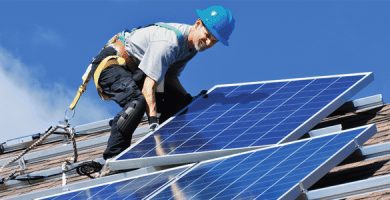Here’s a statistic that will make Australian solar installers green with envy, or at least cry in frustration. The average margin for a rooftop solar installation in the United States market is 40 per cent. In Australia, some installers are struggle to get into double figures.

That actually turns out to be good news for consumers – who in Australia enjoy some of the cheapest prices for installed rooftop solar in the world, and more than 1.5 million homes and businesses have already taken advantage of this.
This in turn has turned Australia into one of the leading markets for rooftop solar in the world, and puts it at the forefront of the battery storage revolution, with many leading battery storage companies using Australia as the launch-pad for their battery storage products, including Tesla, Enphase, LG, Redflow and many others.
Still, the situation with installers and the cost of rooftop PV is an interesting one, although it should be noted that it is not the only factor governing installation rates. In the US, most states retain a generous feed in tariffs, equivalent to the full retail price. In Australia, tariffs have been slashed to a fraction of the retail price.
But the US market is also subject to heavy “balance of system” costs, mostly related to the planning and approvals process, although this is being smoothed out. Still, Australian solar system prices average around $1.63/watt, less than half the $US3.50/watt average price for residential installation in the US.
Part of this is explained by the intense competition in the Australian market, the impact of large utilities in the rooftop installation market, and the tendency for many Australian households to be happy to put up “cheap” solar panels, equipment of lower quality.
But the mark up from installers is still quite stunning. As Deutsche Bank notes in a research report that looks at big price falls from manufacturers:
“Even though we expect some of the cost reductions to be trickled down towards the end customer, we still expect installers to make the most money in the supply chain.”
Geoff Bragg, from the Solar Energy Industries Association in Australia, says margins for Australian installers ranges from around 17 per cent to 26 per cent. “Any Aussie installer marking up less will be heading for closure in my opinion,” he said. And many have in recent years.
The good news for consumers in both countries is that rooftop solar module prices are about to fall sharply, with analysts predicting that module costs could fall by nearly half in the next year to as low as US30c/watt – due to massive amounts of new capacity, and significant cost reductions in the manufacturing process.
Bloomberg New Energy Finance said last week that module prices could fall to US30c/watt in 2017, and now analysts at Deutsche Bank says they now expect module prices to fall as low as US35c/watt.
Deutsche Bank says prices have already fallen to as low as US41c/watt, and US35c/watt is likely to be reached within 6-9 months. Part of the reason is lower import duties, but components such as solar cells have also fallen rapidly, with Taiwanese cells down to US20c/watt, from more than US30c/watt.
As for manufacturers, Deutsche Bank expects margins to contract to the low teens later in 2016, but in 2017 could fall into the single digits. That will put some pressure on share prices for the listed manufacturers. That might make consumers as the happiest of all the components of the solar supply chain.










